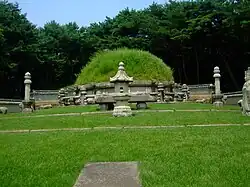| Dongguneung | |
|---|---|
 Geonwonneung | |
| Location | 197 Donggureung-ro, Guri, Gyeonggi Province[1] |
| Coordinates | 37°37′21″N 127°07′55″E / 37.622608°N 127.132075°E |
| Area | 1,96 km²[1] |
| Governing body | Cultural Heritage Administration of Korea |
| Type | Cultural |
| Criteria | iii, iv, vi |
| Designated | 2009 (33rd session) |
| Reference no. | 1319 |
| Region | Asia and Australasia |
 Dongguneung | |
| Korean name | |
| Hangul | |
|---|---|
| Hanja | |
| Revised Romanization | Donggureung |
| McCune–Reischauer | Tongkurŭng |
Dongguneung (lit. 'The Nine Eastern Royal Tombs'), is a cluster of royal tombs from the Joseon dynasty, the largest of its kind in South Korea. 17 Joseon kings and queens are buried here. The cluster also houses a myo-type tomb (of a royal family member). It is located in Guri, Gyeonggi Province.[1][2][3][4][5]
The construction was ordered by King Taejong in 1408 and the ninth tomb was placed there in 1855.[2]
List of tombs
| Tomb | Deceased | Year | |
|---|---|---|---|
| Geonwonneung (건원릉) | King Taejo | 1408 | |
| Mongneung (목릉) | King Seonjo Queen Uiin Queen Inmok | 1600 | |
| Hyeonneung (현릉) | King Munjong Queen Hyeondeok | 1452 | |
| Suneung (수릉) | Crown Prince Hyomyeong (posthumously King Ikjong) Queen Sinjeong | 1890 | |
| Hwineung (휘릉) | Queen Jangnyeol | 1688 | |
| Gyeongneung (경릉) | King Heonjong Queen Hyohyeon Queen Hyojeong | 1849 | |
| Wonneung (원릉) | King Yeongjo Queen Jeongsun | 1776 | |
| Hyeneung (혜릉) | Queen Danui | 1718 | |
| Sungneung (숭릉) | King Hyeonjong Queen Myeongseong | 1674 | |
| Myeongbinmyo (명빈묘) | Royal Noble Consort Myeong of the Andong Kim clan (King Taejong's concubine) | 1479 | |
| Source: Cultural Heritage Administration[3] | |||
References
- 1 2 3 "구리 동구릉 (九里 東九陵)" (in Korean). Cultural Heritage Administration. Retrieved 2015-11-25.
- 1 2 "East Nine Royal Tombs, Guri". Cultural Heritage Administration. Retrieved 2015-11-25.
- 1 2 "구리 동구릉" (in Korean). Cultural Heritage Administration. Retrieved 2016-01-05.
- ↑ "Donggureung Royal Tomb [UNESCO World Heritage] (구리 동구릉 [유네스코 세계문화유산])". Korea Tourism Organisation. Retrieved 2016-01-22.
- ↑ Oh Hong-seok (2009). Traditional Korean Villages. The spirit of Korean cultural roots. Ewha Womans University Press. p. 68. ISBN 9788973007844.
Wikimedia Commons has media related to Donggureung.
This article is issued from Wikipedia. The text is licensed under Creative Commons - Attribution - Sharealike. Additional terms may apply for the media files.